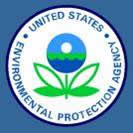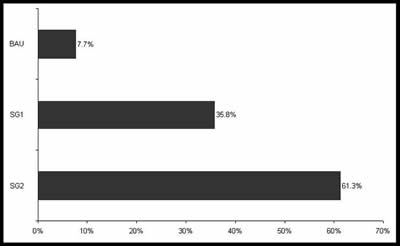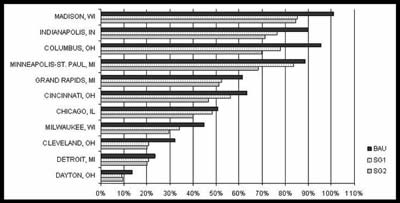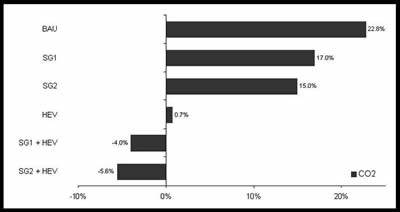 PLUTO
PLUTO
PROJECTING THE IMPACT OF LAND USE AND TRANSPORTATION ON FUTURE AIR QUALITY
IN THE UPPER MIDWESTERN UNITED STATES

OVERVIEW
How will land use decisions made today influence travel behavior and air quality tomorrow? Project PLUTO is an EPA funded study designed to investigate the impact of regional land use patterns on air quality throughout the upper Midwestern United States. The principal goal of this research is to evaluate the effectiveness of "smart growth" land use policies in combating ozone formation and fine particulate air pollution between today and 2050. Through the integration of travel survey data with a set of mobile source emissions and air chemistry models, we will assess the influence of regional land use and technology change scenarios, coupled with ongoing changes in climate, on air quality throughout the states of Minnesota, Wisconsin, Illinois, Michigan, Indiana, and Ohio. Project PLUTO is the first study to evaluate the potential for smart growth land use strategies to improve regional air quality over time and in comparison with conventional technological strategies, such as power plant scrubbers and hybrid vehicles.
Over a decade since the passage of the Clean Air Act Amendments of 1990, many large metropolitan regions of the United States remain in non-attainment for one or more criteria air pollutants regulated by the U.S. Environmental Protection Agency. Confronted with ever increasing rates of personal vehicle travel and energy consumption, unhealthy levels of regional pollutants such as tropospheric ozone (O3) and fine particulate matter (PM) have persisted – and, in some cases, increased – in many regions of the country, despite significant reductions in both mobile and point source emissions achieved through technological emissions controls. While land use patterns characterized by moderate to high population and employment densities, an intermixing of compatible land uses, and pedestrian and transit supportive design techniques have been associated with reduced rates of vehicle travel in the planning literature, few studies have sought to measure the potential benefits of these planning strategies for regional air quality over time. In light of the many uncertainties pertaining to not only the nature of future development patterns, but also to changes in vehicle technologies, energy demand, inter-regional transport of air pollution, and regional climates, an integrated modeling framework is needed to assess the potential for such strategies to measurably improve air quality over the next half century.
Research Approach
The research approach will combine national demographic and travel survey data with vehicle emissions (MOBILE6), regional air quality (CMAQ), and global atmospheric chemistry (MOZART) models to associate land use patterns with O3 and PM in future years. Through the use of the USDOT’s Nationwide Personal Transportation Survey “transferability component,” we will derive estimates of census tract level VMT that may be projected to future time periods in response to “business as usual” and “smart growth” development scenarios (Figure 2). Adjusting for regional and temporal variability in vehicle fleet composition (including hybrid vehicle fractions), travel speeds, coldstart fractions, and ambient temperatures, MOBILE6 will be used to generate a set of vehicle emissions factors that, in combination with the VMT estimates, will be used to estimate daily vehicle emissions (Figure 3). In concert with point source emissions estimates derived from an energy demand analysis, these vehicle emissions estimates will be aggregated to 36 km x 36 km grid cells and incorporated into CMAQ to model regional O3 and PM chemistry under variable development, technology, and climate change scenarios. As a final step, MOZART will be employed to assess the influence of continental and global scale precursor transport on O3 and PM throughout the study region.
Results
Our results to date were recently presented at the 2009 Transportation Research Board Conference in Washington DC. The full presentation can be viewed here. Major findings to date include the following:
- Full hybridization of the vehicle fleet was found to fully offset the impacts of 50 years of population growth on CO2 emissions. An aggressive smart growth scenario was found to reduce the growth in emissions under BAU by 34%.
- Technological change alone will not be sufficient to achieve Kyoto based targets for CO2 reductions from the light duty vehicle fleet. It may be possible to attain 1990 levels of CO2 emissions or lower through a combination of technology and land use change.
- High levels of metropolitan densification hold the potential to meet or exceed reductions in CO2 brought about through HEV technologies over 50 years.
A more detailed discussion of our approach and results is provided in the following articles:
Stone, Brian Jr., Mednick, Adam, Holloway, Tracey, and Spak, Scott. 2009. Mobile source CO2 mitigation through smart growth development and vehicle fleet hybridization. Environmental Science & Technology, in press.
Final results on the implications of smart growth for regional air quality are forthcoming.
Project Team
Dr. Brian Stone, PI, City and Regional Planning Program, Georgia Institute of Technology
Dr. Tracey Holloway, PI, Nelson Institute of Environmental Studies, UW-Madison
Adam Mednick, Dept. of Urban and Regional Planning, UW-Madison
Scot Spak, Nelson Institute of Environmental Studies, UW-Madison
For more information, please contact Brian Stone (stone@gatech.edu) or Tracey Holloway (taholloway@wisc.edu). This research is funded by an EPA Science to Achieve Results Grant #R831840.


